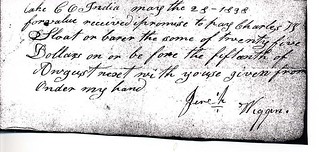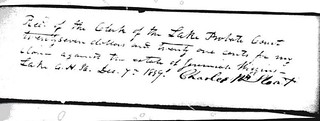Thanks to the Harms family, I have a copy of an abstract of title to the second farm owned by Henry and Johanna (Anna) Harms. It comprised 80 acres on the west side of Randolph Street, straddling 73rd Avenue. They bought it while still living on the
old Harms place.
The abstract starts with the 40 acres that lie on the northwest corner of the intersection of Randolph Street and U.S. 30, marked here on Google satellite view (and I hope I got the upper boundary right):
 (Click on image to enlarge)
(Click on image to enlarge)
The first page tells us that those 40 acres (plus the 40 acres lying immediately north) were bought by Zachariah Elliott from the U.S. government (at the
Winamac land office on January 10, 1852.
That would seem to indicate that Zachariah was the first private owner since the Potawatomi ceded the land to the federal government. Occasionally you find abstracts of title that actually give the name of the Native American who signed the treaty whereby the land was transferred. Unfortunately, this isn't one of them.
After holding the land for nearly two years, Zachariah sold it to John D. Willson (or Wilson).
 (Click on image to enlarge)
(Click on image to enlarge)
Image courtesy of the Eldon Harms family.
I cannot positively identify either of these men in census or any other records besides land-sales records. I don't know where they came from, why they bought land in Lake County, or where they went afterward.
I love the name of the justice of the peace involved in the second sale — Socrates Griswold.
Him I can find in the
1850 Census, a Vermonter born in 1807, living and farming in eastern Ross Township.
Early Land Sales, Lake County shows him buying up some 230 acres in the same general area throughout the course of 1853. But he didn't stick around: by the
1860 Census, he had moved to Valparaiso and become a drayman.
[1]
The next sale, in 1856, brings up a name we know.

This Charles Chester is not, of course,
Truculent Chuck, but his grandfather. We don't know much about this Charles. From the biographical sketch of his son,
Henry, we learn just a little about this Charles and
his father:
His [father], John Chester, was a native of England, whence he came at an early day to Pennsylvania, and for seven years fought in the ranks of the patriots in the Revolutionary war, becoming an officer in the Continental army. He saw and talked with General Washington and was a prominent man. His son Charles, father of Henry, was born in Pennsylvania, and came out to Lake county, Indiana, as a pioneer in 1847, living here until his death in 1874. He married Mary E. Price, a native of Pennsylvania and of German descent, and they were the parents of two daughters and one son that reached maturity.
From the stones in the Chester Cemetery, we learn that Charles lived from
1798 to 1874, and Mary Price Chester from
1811 to 1878.
[2]
Here is the first appearance of the Charles Chester family in Ross Township, in the
1850 Census:
 Image from Ancestry.com.
Image from Ancestry.com.
There are three children: Rebecca, Henry, and Roxanna.
[3] In December 1850, Rebecca married George Miller in Lake County, Indiana. They lived in Hobart Township (1860), then moved to Ross Township (1870), where they and their children lived on a farm somewhere southwest of Merrillville (to judge by their neighbors). By 1880 it appears they had moved to Black Hawk County, Iowa; there Rebecca died in
1881.
In July 1856 Henry Chester married Harriet Perry, daughter of Ezekiel and Olive Perry of Porter County. The Perrys are recorded in the
1850 Census farming in Center Township; by 1860 the parents had moved to Union Township. We need say no more about Henry: so much of this blog has been devoted to him.
Not quite two months later, in August 1856, Roxanna married her brother-in-law, Allen Perry (some 14 years her senior). They remained in Ross Township through the
1860 Census, but then moved to Black Hawk County, Iowa. (I wonder if things got awkward after Henry and Harriet
divorced.)
To be continued.
_______________
[1] In 1856 he married Mary Frasier in Porter County (Indiana Marriage Collection). They remained in Valparaiso through the 1870 Census; the 1880 Census records them in Wisconsin, apparently visiting a niece; but they may have settled there, because both Socrates and Mary died there in December 1893, within a few days of each other. And I wonder if there is a story behind that.
[2] Someone has posted a photo of a Mary Chester on the findagrave.com entry, but unfortunately the photo is not of Mary Price, Charles' wife, but Mary Baird, the third wife of Charles' son, Henry.
[3] The wording of the biographical sketch quoted above suggests that Charles and Mary had at least one other child that did not live to maturity, but I can't find any information about any such child.














